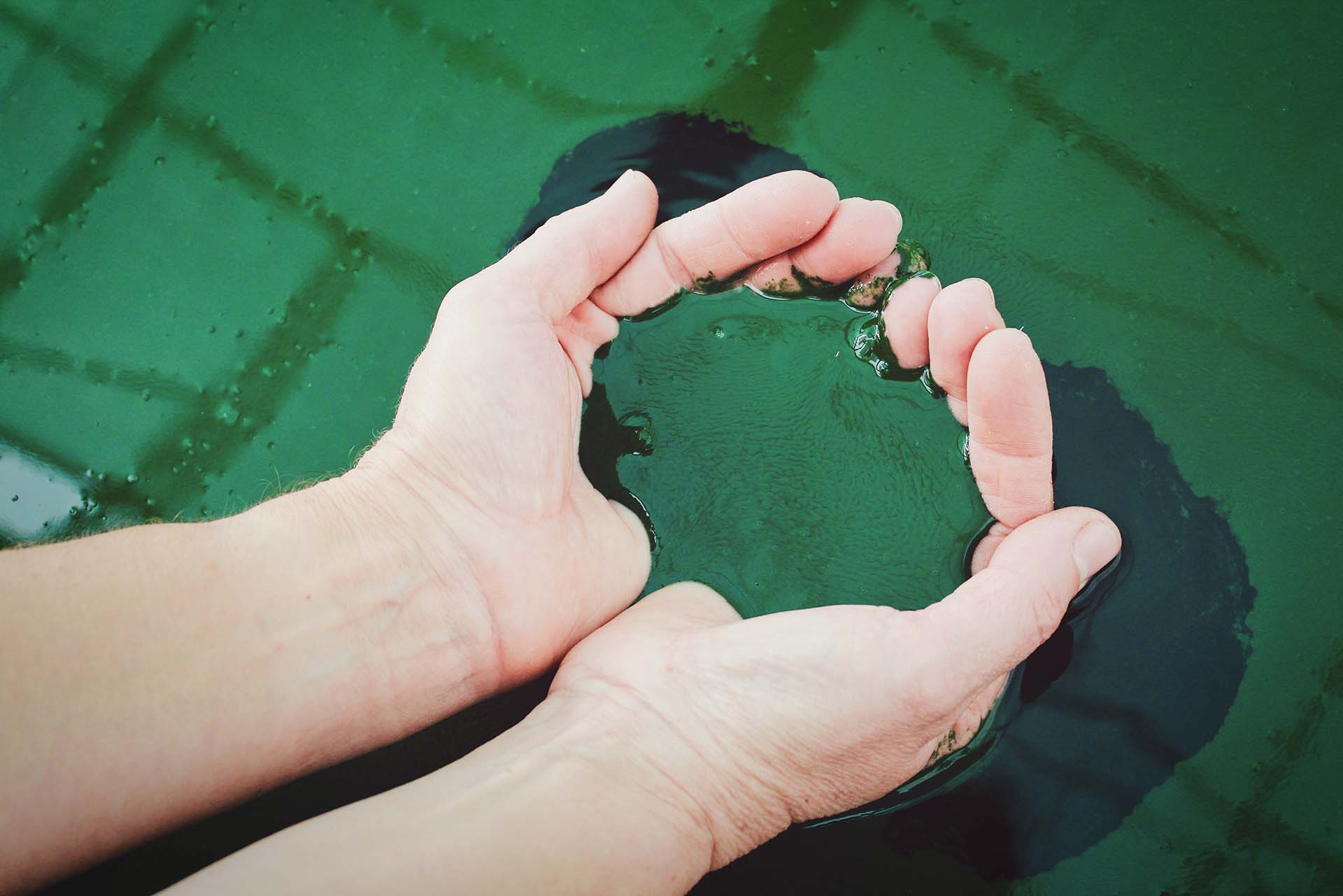When talking about algae, most people think of plant-like organisms floating in sea water. These are macroalgae – better known as seaweed. Microalgae, on the other hand, are unicellular species of microscopic size, invisible to the naked eye. They are experts in using light to convert CO2 into high-grade molecules, for example nutrients like proteins and lipids. Microalgae are very diverse: there are thousands of different species, of which we can currently cultivate about 20 to 30. Spirulina and Chlorella are the most famous of these because they are the main microalgae used in food.
During the Second World War and shortly thereafter, there was huge enthusiasm for algae, with people viewing them as a future solution to global hunger and an alternative for polluting fossil resources. In the following decades, however, problems (primarily with upscaling) led to a waning interest in Europe. This was in contrast with the situation in Asia – particularly in Japan – where the sector did develop strongly.
By the start of this millennium, European research efforts into algae were renewed, but mainly focused on microalgae’s potential as biofuel. “This biofuel bubble burst about 10 years ago,” says Leen Bastiaens of the Flemish institute for technological research VITO, which coordinates the IDEA project. “From then on, the focus shifted to more high-grade applications, like in food and cosmetics.”
Farming in different seasons, all year round
One of the main microalgae questions remaining concerns the climate conditions in which they can be grown. One of the goals of the Interreg North-West Europe project IDEA is to find out whether microalgae could be efficiently cultivated in the partner countries: Belgium, Germany, France, The Netherlands, Ireland, and the UK. These countries share a similar climate that differs significantly from both South- and North-European conditions.
“It is a common misconception that all microalgae require the same high temperatures and high light intensity,” says Bastiaens. “Their demands are in reality quite different. For example, some really can’t cope with the extremely sunny conditions in certain regions of Spain and Portugal.”
“You can farm different microalgae in different seasons, all year round. This way, you also minimize the costs needed for additional lighting, heating, and cooling.” – Leen Bastiaens, VITO
IDEA project partners first selected six promising microalgae species, which included the usual suspects Spirulina and Chlorella but also the less familiar Chloromonas, Scenedesmus, Porphyridium and Nannochloropsis. They then set up a system simulating seasonal crops. “You can compare it to the concept of different spring, summer, and winter cereals. In the same way, you can farm different microalgae in different seasons, all year round. This way, you also minimize the costs needed for additional lighting, heating, and cooling.”
The microalgae still need to be cultivated in a predominantly controlled environment such as in photobioreactors. The IDEA project partners primarily used the Belgian ‘Sunbuilt’ reactor, developed by VITO in a previous European project together with the Thomas More University of Applied Sciences. For harvesting and the re-use of resources such as water, they also employed VITO’s Membrane Algae Filtration technology. Project partners also looked into optimal methods for storing microalgae, considering all steps in the production process.
An ecosystem of microalgae start-ups
To provide interested industry players with a concrete idea of the possibilities of working with microalgae, IDEA partner organizations demonstrated a range of applications in different kinds of products. Chlorella and Spirulina (the only microalgae currently approved for human food production) were integrated in biscuits, and algae oil was extracted for cosmic applications (specifically skin care products).
In an attempt to valorize the entire biomass of the algae, defatted microalgae components were used as bioactive additives for animal feed (in dog and chicken feed). “The bioactive additives give the animal feeds additional healthy properties,” says Bastiaens. “They help to lower blood pressure, boost the immune system, and improve the health of the gut flora.”
“What is needed now is for companies to invest in algae ingredients and boost large-scale production of microalgae.” – Leen Bastiaens, VITO
These products are not yet commercially available – currently they are acting as teasers to pique the interest of companies. “What is needed now is for companies to invest in algae ingredients and boost large-scale production of microalgae. This way, we can bridge the infamous ‘valley of death’ between pilot projects and economically viable initiatives.”
A greener future
VITO will continue to work with the other IDEA partners towards microalgae commercial success, until the project wraps up at the end of 2023. One of the goals for the remaining time is to further lower the cost of production and make it more sustainable by valorizing by-products such as wastewater and CO2. Project partners will also investigate the use of bioactive additives as ingredients in biostimulants and biopesticides.
The partners also intend to take action regarding policy, asking for measures to be put in place to discourage the import of cheaper and less sustainable microalgae products (primarily from Asia) and to encourage local production. Partners also aim to encourage updates to relevant food legislation.
Read this article to find out why Wallonia is investing in plant-based protein innovation
Even after the IDEA project ends, there will still be much work left to be done. “But we are on the right path,” says Bastiaens. “For example, we didn’t focus on aquaculture in IDEA, because there are already well-established initiatives in this field, like those of Proviron and Tomalgae in Belgium. These companies have already been using microalgae to feed seafood like fish and shrimps for several years.”
Bastiaens also points to the involvement of Gova from Antwerp, a distributor of ingredients used for the production of cosmetics. Another good Belgian example is Heirbaut, a specialist in sustainable agriculture. “There is a whole ecosystem of start-ups that are interested in microalgae. In the last few years, more and more actors have been turning plans into action. What we now need is larger investments, so we can reach the next level of large-scale industrial success.”


